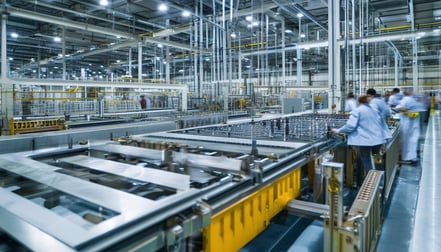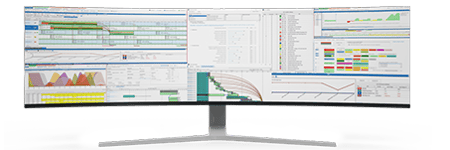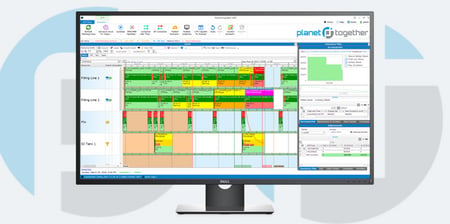Maximizing Efficiency with Flow Production Planning
Finding ways to enhance efficiency, reduce costs, and improve production workflows is critical for any Plant Manager in manufacturing. Flow production planning is emerging as a key strategy to achieve these objectives, especially in environments where high-volume, low-variety production processes are essential.
Integrating advanced production planning and scheduling software, such as PlanetTogether, with powerful enterprise systems like SAP, Oracle, Microsoft, Kinaxis, or Aveva, can significantly amplify the benefits of flow production.
This blog will explore the core principles of flow production planning, its advantages, and how seamless integration between PlanetTogether and ERP (Enterprise Resource Planning) systems can optimize operations, minimize waste, and improve overall productivity in industrial manufacturing facilities.

Flow Production Planning
Flow production, also known as continuous production, focuses on a streamlined, unbroken sequence in the manufacturing process, where materials flow from one production stage to the next without interruption. Unlike batch production, flow production seeks to eliminate pauses and bottlenecks, achieving a continuous, high-speed manufacturing flow. This approach is particularly beneficial for industries producing standardized products, such as automotive parts, consumer electronics, and various packaged goods.
In flow production, planning must align resources, labor, and machinery to ensure a smooth transition between each step. The goal is to minimize downtime, reduce inventory levels, and decrease lead times. However, managing flow production effectively requires a sophisticated level of coordination and real-time data to avoid disruptions.

Key Components of Flow Production Planning
To implement flow production planning, Plant Managers need to focus on:
Process Standardization: Creating standard procedures and setting consistent expectations across production stages.
Balancing Workflows: Ensuring each workstation or production phase has a similar load to prevent bottlenecks.
Quality Control Integration: Embedding quality checks throughout the process to prevent downstream defects.
Real-Time Monitoring: Utilizing technology to oversee each production stage, ensuring there are no delays or inefficiencies.
Flexible Scheduling: Adjusting production schedules in response to demand fluctuations or equipment issues.
By adhering to these principles, flow production can lead to higher throughput and enhanced productivity. However, the implementation of these practices can be challenging without the right tools.
![]()

The Role of Software Integration in Flow Production Planning
Integrating PlanetTogether with an ERP system like SAP, Oracle, Microsoft, Kinaxis, or Aveva is instrumental in making flow production planning more effective. Here’s how this combination works to streamline operations:
Unified Data Management: Integrating PlanetTogether with an ERP system allows for centralized data management. When production planning and scheduling software connects directly to the ERP, it draws real-time data on inventory, workforce, demand forecasts, and machine availability, making flow production planning more accurate.
Dynamic Scheduling and Rescheduling: One of the primary challenges in flow production is accommodating unexpected disruptions, such as equipment malfunctions or material shortages. With integrated systems, PlanetTogether can instantly pull data from ERP systems to reschedule workflows and resources dynamically, ensuring minimal downtime.
Enhanced Resource Optimization: ERP systems provide insights into labor, machine capacities, and resource allocations. When PlanetTogether integrates with these platforms, it can allocate resources more effectively, balancing workloads across production stages to prevent bottlenecks and achieve steady flow.
Improved Visibility and Communication: Integrating PlanetTogether with ERP systems enhances visibility into each production phase, from materials procurement to end-product output. This transparency fosters collaboration between departments, helping Plant Managers make informed decisions in real-time.
Proactive Quality Management: Quality assurance in flow production is essential, as defects discovered late can halt the entire process. Integrated systems enable continuous quality monitoring and flag issues immediately. PlanetTogether can sync with ERP quality management modules to automate quality checks, thus maintaining standards across all production stages.

Benefits of Integrating PlanetTogether with ERP Systems for Flow Production Planning
For Plant Managers, integrating PlanetTogether with SAP, Oracle, Microsoft, Kinaxis, or Aveva creates several advantages that enhance flow production capabilities. Here are the major benefits:
Reduced Lead Times and Faster Delivery
With PlanetTogether and ERP integration, real-time data on inventory and machine availability becomes accessible, enabling production schedules that align closely with demand. By minimizing idle time between processes, flow production planning shortens lead times, ensuring faster product delivery and improving customer satisfaction.
Lower Operating Costs
Continuous flow production, supported by robust integration, reduces inventory requirements and limits excess work-in-progress materials. By streamlining operations and minimizing wastage, integrated planning and scheduling solutions help to cut costs across the board. ERP systems track procurement and inventory levels, while PlanetTogether adjusts production schedules accordingly, resulting in an optimal flow without unnecessary expenses.
Enhanced Scalability and Flexibility
Industries with fluctuating demand can face significant planning challenges. Integrated systems allow for agile scheduling that adapts to changes without impacting production flow. If demand spikes or a key supplier faces delays, PlanetTogether, in sync with ERP data, can make real-time adjustments, aligning production with market needs while minimizing downtime.
Increased Capacity Utilization
Flow production planning aims to use all available capacity without overburdening resources. Integrating PlanetTogether with ERP systems ensures that machines, labor, and materials are fully utilized, without the risk of bottlenecks or resource overloading. This optimized utilization enhances overall productivity and improves return on investment (ROI).
Real-Time Performance Monitoring and Analytics
The integration of PlanetTogether with ERP systems gives Plant Managers access to real-time performance metrics. Dashboards and analytics tools visualize key performance indicators (KPIs), making it easier to track efficiency, production rate, downtime, and resource utilization. With this data, Plant Managers can make proactive adjustments to enhance flow and optimize production.

Best Practices for Implementing Flow Production Planning with Integrated Systems
To fully leverage the benefits of PlanetTogether and ERP integration for flow production planning, consider these best practices:
Define Clear Goals and KPIs: Set specific goals for flow production—whether it's reducing lead time, improving resource utilization, or minimizing waste. Use KPIs such as cycle time, throughput rate, and defect rates to measure progress.
Prioritize Data Accuracy: Integrated systems rely heavily on accurate, real-time data. Ensure that data entry processes are streamlined, and all departments are aligned on maintaining data quality.
Foster Cross-Department Collaboration: Flow production planning spans multiple departments, from procurement to quality control. Promote a culture of collaboration to ensure that each team understands their role in supporting flow production.
Conduct Regular Training and Reviews: Staff at all levels should be trained on how to use the integrated system effectively. Regular training sessions and reviews will help keep teams up-to-date on best practices and new features within the software.
Continuously Monitor and Improve: Flow production planning is an ongoing process that requires constant improvement. Use data from PlanetTogether and ERP systems to identify areas for improvement, implementing incremental changes that enhance productivity.
Flow production planning is essential for modern industrial manufacturing facilities seeking to maximize efficiency, minimize costs, and improve productivity. When combined with the capabilities of PlanetTogether and ERP systems like SAP, Oracle, Microsoft, Kinaxis, or Aveva, Plant Managers gain a powerful toolset to optimize production flows, reduce waste, and improve resource utilization. By following best practices and leveraging the power of integrated software solutions, Plant Managers can achieve a seamless production flow that meets today’s complex manufacturing demands.
The right integration strategy not only facilitates continuous production but also empowers Plant Managers to respond dynamically to market shifts and internal challenges. With flow production planning and advanced software integration, industrial manufacturing facilities can set the foundation for long-term success and sustainable growth.
Are you ready to take your manufacturing operations to the next level? Contact us today to learn more about how PlanetTogether can help you achieve your goals and drive success in your industry.
Topics: Industrial Manufacturing, PlanetTogether Software, Integrating PlanetTogether, Enhanced Resource Optimization, Improved Visibility and Collaboration, Lower Operating Costs, Unified Data Management, Proactive Quality Management, Increased Capacity Utilization, Dynamic Scheduling and Rescheduling, Reduced Lead Times and Faster Delivery, Enhanced Scalability and Flexibility, Real-Time Performance Monitoring and Analytics




















LEAVE A COMMENT